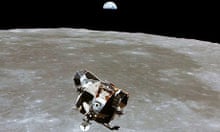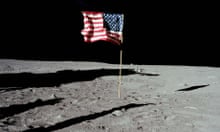Few people who remember the 1960s can fail to have been inspired by the drama and excitement of the space missions, which pitted the United States against the Soviet Union in a race to land a man on the moon. Today there is still a massively competitive space race; but yesterday the Barack Obama administration cancelled its Constellation programme, which had aimed to put astronauts back on the moon. With the US effectively out of the race to the moon, the field is now clear for India, China and Japan.
The 1960s space race was about military prowess. This time it's about economic and technical leadership, but in terms of our future prosperity it is just as significant.
The US says it no longer wants to spend big money on rockets and will let private industry build them. Nasa also plans to develop ways of refuelling spacecraft in space to cut the costs of taking them there. This might be the best way eventually to get humans to Mars. There will be robotic missions to explore where humans want to go. I hope this means that at last we will get a sample of Mars and the missions won't be an expensive waste of money.
The main costs of the space programme are salaries – in relative terms the components cost very little. But you can't sack everyone in Nasa, because you know that at some future point you'll need their expertise and experience. I fear that in practice Nasa's leaders will be tempted to have their scientists undertake more background studies. But we've done all the studies we need to obtain samples from Mars and know exactly what to do with them.
Why do we need such samples? For a start, it is not possible to have a manned mission to Mars until we can definitively answer the question of whether there is any life there. Without this information, we risk astronauts bringing back microbes to Earth which could wipe out life on our planet. I hope cancelling the moon mission will in fact accelerate humans going to Mars, not mean that something even more inspirational will slip back.
Under George W Bush, the US had planned a manned lunar mission by 2015; this was then pushed back to 2018; now it's gone altogether. And Europe isn't any faster when it comes to going to Mars: the European Space Agency wanted to build ExoMars – a robotic mission to Mars – by 2009. But it's already 2010: they've been going for seven years and seem to have little to show for it.
They've gone for a high-cost failsafe mission which is long in the planning; but I believe they should be doing smaller, faster, cheaper projects – those which require a limited number of people but can be quickly completed, and through which they can learn a lot, even if the mission "fails" – although I believe there's no such thing as failure if you learn something. I headed the Beagle2 Mars mission in 2003, and in my view it's impossible to ensure a mission has a 99.9% chance of success. It's far better to spend the money on, say, three missions that have 95% chance. Europe could have done Beagle again by 2007, but instead we are still waiting.
By contrast, in India and China things are happening quickly – these countries are not afraid of making mistakes and learning from them. They've both had recent lunar missions; they're now planning to land on the surface with a robot; and after that will come a manned mission. I believe that the next man or woman on the moon will be Chinese.
And the importance of this goes way beyond space travel, once a nation shows it has the ambition, the ingenuity and the economic strength to mount such a mission. Just as the launch of Sputnik in 1957 showed that the Soviets were a technological power to be reckoned with, so it will be with India or China. These countries recognise that dynamic economies need to create something for the nation to export – be it providing the innovation for electronic goods, or whatever. Lunar missions – and, beyond that, Mars missions – are hugely effective in bringing young people into science and technology.
In the west, we have now had two generations who have missed out on such inspiration. Indeed, we risk our top scientists migrating to Asia.
If you went into a British classroom and asked how many children wanted to be a scientist, on average 2% would put their hands up. In India, about 30% would say yes. That's the difference between the west and the emerging economies; and that's why, ultimately, if we don't address this situation, it could be us staffing their call centres.



